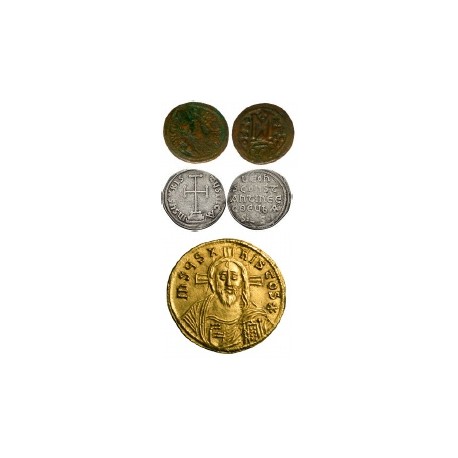Cart
0
Product
Products
(empty)
No products
To be determined
Shipping
$0.00
Total
Product successfully added to your shopping cart
Quantity
Total
There are 0 items in your cart.
There is 1 item in your cart.
Total products
Total shipping
To be determined
Total
More info
Medieval Money
&
Old World Currency
“During the medieval times, money consisted of metal coins. Paper currency was unknown at the time. The value of the coin depended on which type of metal it was made from. The most valuable coins were gold then silver, and then copper. This was widely recognized as the 'standard' of currency throughout the medieval world. There were many different coins, each of which had different designs, weights, inscriptions, and the purity of the metals varied greatly. In the Byzantine Empire, gold, silver, and copper coins were minted and used throughout the medieval period. The most important Byzantine coined was the gold nomisma. This is because it was the standard of exchange in the Mediterranean trade. The most important mint in the Byzantine Empire was in Constantinople, but there were other provincial mints as well. The Islamic world of this time had no coins of its own, but as the Muslims conquered the Byzantines, they adopted the minting processes, and soon started minting their own coins. The most important Islamic coin was the gold dinar. The dinar had inscriptions from the Qur'an that reflected its Islamic Ideals. In the Islamic world, the relationship among values of coins was not set, so it was determined in the marketplace by supply and demand. The coins of Western Europe were very diverse; they had many different authorities because of Feudalism so the coins vary in size, shape, and weight. But increased trading led to the standardizing of coins. This allowed for trade from one region the next. Charlemagne standardized the coinage system in his empire. The basic coin in his empire was the silver coin called the denarius or penny.” nickshanks.com
Nomisma
Struck during the Byzantine empire, made of 98% pure gold, and most often depicting images of Jesus Christ, the Nomisma was of great worth. Soldiers in the calvary earned one gold Nomisma a year for each year of service with a maximum payment of 12 gold nomisma’s for 12+ years of service. To aid in payments and trade, coins of smaller value were minted in bronze and silver. These coins also carried Christian iconography and Greek inscriptions.
•
Folles
: 288 bronze folles equaled one gold nomisma.
•
Miliaresia
: 12 silver miliaresia equaled one gold nomisma
.



Dinar
The first Islamic currency was the Dinar. The name is derived from denarius, a Roman currency. There were also ½ dinars and 1/3 dinars.
Pound
The pound sterling is the oldest form of currency still used today.
The pound was a unit of account in Anglo-Saxon England, equal to 240 silver pennies and equivalent to one pound weight of silver. The origins of sterling lie in the reign of King Offa of Mercia, (757–796) who introduced the silver penny. The early pennies were struck from fine silver (as pure as was available). However, in 1158, a new coinage was introduced by King Henry II (known as the Tealby penny) which was struck from .925 (92.5%) silver. This became the standard until the 20th century and is today known as sterling silver, named after its association with the currency. The English currency was almost exclusively silver until 1344, when the gold noble was successfully introduced into circulation. However, silver remained the legal basis for sterling until 1816.
•
Pound
: 20 shillings (20s).
•
Sovereign
: One pound (20 Shillings) made as a gold coin. Rarely used.
•
Guinea
: 21 shillings. Small gold coin. Rarely used. Term still used in horse racing and auctions.
Less than a Pound but more than a Shilling
•
Mark
: A measure of silver, generally eight ounces. In England, a mark was worth 13 shillings and four pence, or two thirds of one pound.
•
Half Sovereign
: 10 shillings. Small gold coin. Rarely used.
•
Crown
(“dollar”) 1 crown = 5 shillings







Penny (d)
The English penny was called DENARIUS, hence the abbreviation "d." Also called “copper.” Until modern times, the base unit of currency in Britain and the chief every-day coin. Originally silver. Later a large bronze coin.
Less than a Penny
•
Half Penny
(pronounced “hay-p’ny’”): ½ penny. Small bronze coin.
•
Farthing
: ¼ penny. Small bronze coin. Other sources: Wikipedia.com woodlands-junior.kent.sch.uk/customs/.../moneyold.htm gold-traders.co.uk hemyockcastle.co.uk Tulane.edu







